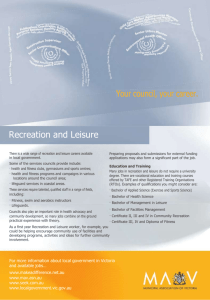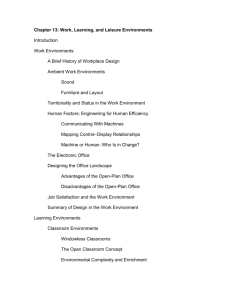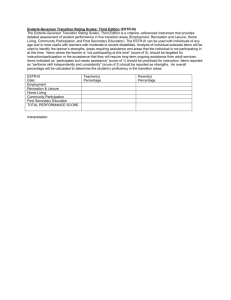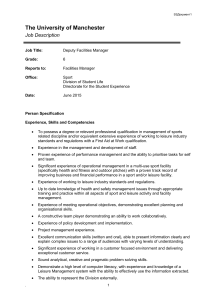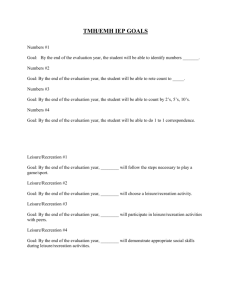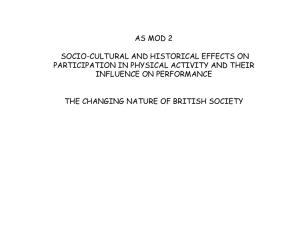Daniel McLean, PhD, CPRP and Amy Hurd, PhD ISBN-13: 978
advertisement
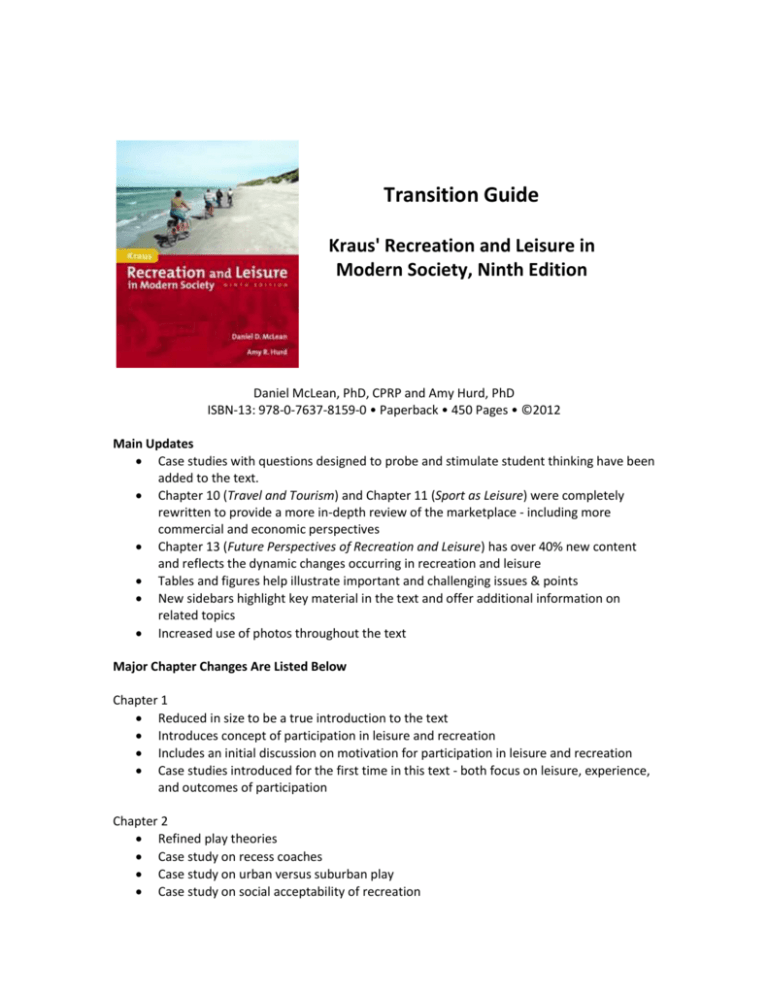
Transition Guide Kraus' Recreation and Leisure in Modern Society, Ninth Edition Daniel McLean, PhD, CPRP and Amy Hurd, PhD ISBN-13: 978-0-7637-8159-0 • Paperback • 450 Pages • ©2012 Main Updates Case studies with questions designed to probe and stimulate student thinking have been added to the text. Chapter 10 (Travel and Tourism) and Chapter 11 (Sport as Leisure) were completely rewritten to provide a more in-depth review of the marketplace - including more commercial and economic perspectives Chapter 13 (Future Perspectives of Recreation and Leisure) has over 40% new content and reflects the dynamic changes occurring in recreation and leisure Tables and figures help illustrate important and challenging issues & points New sidebars highlight key material in the text and offer additional information on related topics Increased use of photos throughout the text Major Chapter Changes Are Listed Below Chapter 1 Reduced in size to be a true introduction to the text Introduces concept of participation in leisure and recreation Includes an initial discussion on motivation for participation in leisure and recreation Case studies introduced for the first time in this text - both focus on leisure, experience, and outcomes of participation Chapter 2 Refined play theories Case study on recess coaches Case study on urban versus suburban play Case study on social acceptability of recreation Enhanced comparison of play, recreation, and leisure Chapter 3 How workweeks have changed from 1860 to 1009 Case study on the typology of urban parks from 180-1965 The challenges of defining popular/mass culture - new sidebar Case study on President Franklin Roosevelt and his legacy for parks and recreation Chapter 4 Focus on the current economic decline, the history of economic declines, and the impact on leisure and recreation Expanded discussion on the Land & Water Conservation Fund Expanded discussion on designing facilities for ethnic minorities Case study: African Americans blog about the outdoors The growth of women in sport and recreation through the growth of women’s World Cup Soccer Case Study: The importance of individual donors to nonprofits - the Salvation Army and the Kroc family Stratification of salaries and the impact on the middle class Updated information on trends, including: maturation of the leisure services field; the new realities for city, county and state governments; the internet; physical activity and others Chapter 5 Updated physical activity and obesity statistics Case study on the obesity epidemic Case study on the “Fun-employed” Case study on the balance between work and leisure Restructured section on emotional motivators New section on happiness and well being New section on serious leisure New section on taboo recreation Chapter 6 Moved age factors into this chapter Case study on helicopter parents Case study on children, nature, and play Case study on Title IX Updated statistics on all socio-demographic variables Case study on racial differences in basketball participation Case study on racial and ethnic constraints Chapter 7 o o o o Change in function 4 to focus on positive youth development Case study on the impact of after-school Case study on intergenerational programming Real examples from the field on the redevelopment of land into usable space o o o New information on local programs impacting change in their communities Real examples of recreational programs promoting economic health and stability Case study on youth and the arts Chapter 8 Case studies focusing on: o Understanding the Ten Major Elements in the Modern Leisure Service Delivery System o The Influence of Homeowner Associations on Community Park and Recreation Agencies o What Makes an Excellent City Park System o Cost Recovery as an example of the changing financial picture of public parks and recreation o Extreme Sports Almost all sections were updated with current information, new sidebars expanding on the text, and new sections The expansion of information strengthens the texts focus on changing conditions and political and social environments Commercial recreation section expanded and strengthened recognizing the increasing influence of the commercial enterprise Chapter 9 Completely revised therapeutic recreation section Enhanced discussion on community and clinical settings for therapeutic recreation New discussion on the Leisure Ability Model and the Health Protection-Health Promotion Model of therapeutic recreation Case study on the ADA Updates program offerings in MWR Discussion on the health and wellness benefits of employee recreation Case study on employee services Enhanced job comparisons among the five specialized services areas Chapter 10 Completely revised chapter Updated statistics on the scope of tourism Discussion on the three aspects of commercial recreation Case study on cultural and historical tourism Enhanced section on sport tourism Case study on traveling “green” New section on hostelling New section on culinary tourism Case study on top 10 global travel forecasts Chapter 11 This chapter was completely rewritten, retaining relevant information from the last edition, but with a stronger focus on sport, leisure, and society Case studies focusing on: o Master Planning a Sport Facility o Measuring sport participation is a challenge for economists and marketers o Game On — The World is Watching More than Ever o How Old is Too Old to Participate in Sport The evolution of sport and leisure retooled strengthening the content Section on “patterns of sport involvement, “team sport participation,” casual sport participation,” and “spectators” expanded, more current, and linked more directly to recreation and leisure Definition of sport broadened and includes sports such a surfing Relationships between big business, sport, advertising, and spectators explored Fan Cost Index and other indices updated


